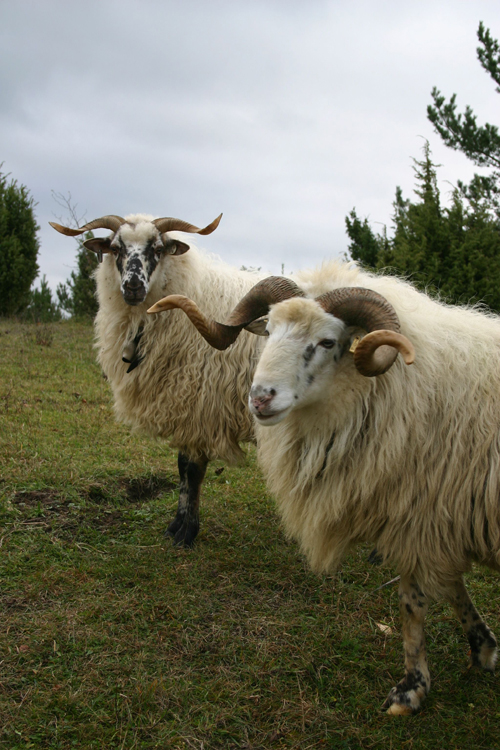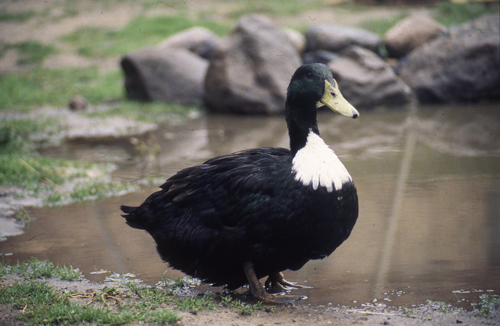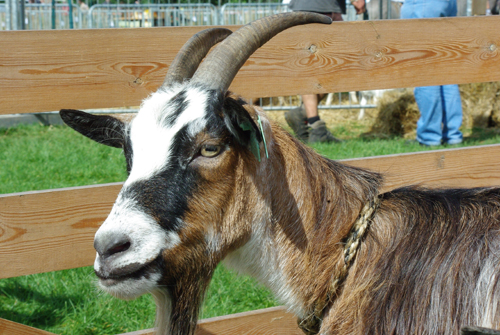Introduction
The ability to act rapidly to protect endangered livestock breeds in emergencies or unforeseen circumstances is the central theme of ELBARN. For this to be possible, much prior planning is required. A review of existing laws and regulations is required to make sure that they are compatible with this idea. It is also necessary to raise awareness of the importance of animal genetic diversity amongst veterinaries and official bodies. The ELBARN Ark and Rescue Centres (A&RCs) can provide a framework for successful rescue actions – but this has to be supported by adequate regulation and knowledgeable practitioners.
The following guidelines have been prepared to set out the process of rescue, review the current legal situation and outline needs for successful action. The guidelines have been set in motion by the contributors to “Work Group 1: Rescue and Quarantine” at the ELBARN Workshop in Kutna Hora, Czech Republic in February 2008. They have been completed by the staff of the SAVE Foundation in consultation with the World Organisation for Animal Health (OIE) and the European Commission’s Directorate General for Health and Consumer Affairs (DG SANCO).
 |
|
photo: C. Simantke
Walachen Sheep – Zackel-type sheep found in eastern Moravia, Czech Republic and Slovakia
|
Principles of Rescue
Rescue is a temporary act
This means that action takes place in cases of emergency. Rehabilitation of a breed includes a long term breeding programme, informative advertising, promotion of products and services.
Professional accomplishment
Rescuing should act in a most professional way. Therefore a net of experts and stakeholders is needed for identification of the needs, knowledge of the breeds and varieties taken into consideration, planning and implementation.
Set up emergency funds
Emergency funds are necessary during a monitoring process in a country or region, but also in countries where the conservation structure is doing well. Here also cases of emergency can take place, e.g. when a breeder gives up breeding and keeping, in case of natural disasters or diseases. Here money currently available for culling animals or as compensation for culled animals could be used for emergency measures in cases of outbreaks of disease.
Verification of the rescued breed
The breed needs to be verified. In some cases there might not be time for verification. An expert should make a preliminary identification. An exact verification should take place as soon after the rescue action as possible.
Ex situ conservation (in gene banks)
Ex-situ conservation (storage, collection and cryoconservation of semen, ova, embryos etc.) are required in all circumstances as last resort and insurance.
Needs for Successful Rescue of a Rare Breed
Preventive action
It is important to act before a rescue action is necessary: Breeds should be characterised, a complete census should take place and long-term monitoring should be in place in each country or region (see Breeding Guidelines for more details). A decentralized system for identification of local breeds and varieties is necessary. For characterisation, morphologic, genetic, functional and cultural aspects need to be taken into consideration.
National Committee
Identification of the breeds and varieties should be undertaken by a National Committee for AnGR. The composition of this committee needs to be multidisciplinary, including the officially appointed National Coordinator for the Management of AnGR by each country, NGO stakeholders, stakeholders of nature conservation and cultural heritage organisations. This committee should be in interaction with ELBARN.
Reference point
A National (or regional) reference point or contact person is needed, with all available information of breeds and varieties of a country. This point should be communicated also to veterinarian / sanitary services and the public. This reference point should be in close interaction with ELBARN.
Training of veterinarians
Veterinarians should be educated about rare breeds in order to be able to identify important breeds and to provide information to the public.
Conservation Value
The conservation value of the farm animal sometimes cannot be verified immediately. Therefore a verification of the conservation value is necessary as soon as possible after the rescue action.
Threshold for a rescue action
The lowest threshold for an action needs to be defined. This cannot be done within a general definition. Different factors have an influence in the threshold for a need of action. In case of rare breeds, extinction takes place before the last remaining animals have died. For the lowest threshold, factors such as the situation of the herd and their keepers, numbers of males and females in reproduction, natural, historical and cultural factors play a role. Therefore the above mentioned National committee and or the National reference point are important decision-making units.
Rescue Centres – Requirements
As it was defined before, a Rescue Centre is any centre / station with free space for hosting rare breeds (for a certain number of animals of a certain species) in a short time period for emergency reasons. This places need to be identified to re-place a breed, a herd or a group of rare farm animals.
Requirements are:
- Free space
- Flexibility in terms of sanitary status, possibilities for isolation
- Readiness for collaboration - agreement
- Registration as a rescue centre
A rescue centre should have the character of an A&RC with free facilities (see A&RC Guidelines). Officially running farms like state farms, university farms etc often have space for hosting animals on a shot-term basis. This information needs to be stored in the ELBARN database. There is a need for a written agreement with the rescue centre. This agreement should include requirement to inform about any changes in status, availability of places and so forth. A sample agreement could be worked out by ELBARN (within the area actions).
The official sanitary status of the rescue centre as a whole could be endangered in case of hosting animals with an unknown sanitary status. This is important in several cases of diseases like Maedi Visna, CAE, Brucellosis, Tuberculosis etc. The related authorities for sanitary rules and –management must be included in the process. Also the related authorities for the starting of the rehabilitation process should be identified (breed association, governmental authorities).
After the rescue operation, the re-integration process of the breed into e.g. a breeding programme should start immediately after valuation.
Process of rescue
The process of rescue depends on the needs and facts discussed above. An ideal scenario looks like this:
- A herd or animal at risk is identified.
- This person calls e.g. a veterinarian.
- The veterinarian calls the national contact point and uses the ELBARN database to find more information and decide if this is an endangered breed.
- If a Rescue action is needed, the best A&RC nearby will be identified and an agreement with the farmer will be made.
- The herd is re-located.
Afterwards, a precise valuation follows and a permanent place needs to be found. A herdbook will be established or the animals included in an already existing herdbook and the re-integration process can start. Possibilities for herdbook keeping and data collection will be available at all A&RCs.
 |
|
photo: A. Feldmann
Pommern Duck – found in Germany, this type of duck was once found all over Europe.
|
Rescue in the Case of an Outbreak of a Disease
Introduction
Foot-and-mouth disease (FMD) is a highly contagious viral disease of biungulates. FMD has no public health importance, however, due to its exceptional economic importance, it is on the top of list A diseases of the World Organisation for Animal Health (OIE). Because of this fact, these guidelines focus on FMD.
Necessary measures to protect animals indispensable for the survival of a specific breed are identified as follows:
Measures BEFORE an outbreak
A list of holdings (approved centres)
Here animals are kept for purposes related to the conservation of animals that are indispensable for the survival of that breed (rare breeds, nucleus groups), so that they may benefit from any special measures that may apply at the time of an FMD outbreak.
- A list of registered holdings (approved centres) must be established (by the state):
- These holdings should be located in different regions of a country, to be in place when outbreaks occur.
- Conditions for an approved centre (EU Council Directive 92/65 Annex C):
- holdings should be clearly demarcated and separated from surroundings or the animals confined and located so as not to pose a health risk to agricultural holdings whose health status might be jeopardised
- have adequate means for
- capture
- confining and isolating animals
- have available adequate quarantinefacilities (for at least 30 days)
- approved procedures for animals coming from non-approved sources
Infrastructural factors (OIE Terrestrial Animal Health Code, Art. 4.4.3.2)
Structural aspects of the establishments within a compartment contribute to the effectiveness of its biosecurity. Consideration should be given to:
- fencing or other effective means of physical separation
- facilities for people entry including access control, changing area and showers
- vehicle access including washing and disinfection procedures
- unloading and loading facilities
- isolation facilities for newly introduced animals
- facilities for the introduction of material and equipment
- infrastructure to store feed and veterinary products
- disposal of carcasses, manure and waste
- water supply
- measures to prevent exposure to living mechanical or biological vectors such as insects, rodents and wild birds
- air supply
- feed supply/source
Breed at risk register
A register of breeds at risk needs to be compiled to identify the animals, which should benefit from special measures in case of an outbreak (of FMD).
(Therefore a herdbook is a pre-condition, also in the case of vaccination to identify the offspring).
Transport
Animals are usually not allowed to enter or to leave the holding. By way of derogation from the prohibitions provided for, the competent authority may authorise movements onto and off the holding, subject to all conditions necessary in order to avoid the spread of the disease and/or virus.
Further, the transport comes under the EU rules for transportation of animals (e.g. EU regulation 1/2005). Facilities to be in place are:
- leak proof trailer
- sealed trailer to prevent spread of germs
Contract with the registered Holding
A contract with all details about the necessary equipment and appointments should be made with the place which comes into consideration is important. This contract should be made with the appropriate governmental authority of the country. The contract must include (according to annex C, Council directive 92/65):
- general information about holding
- animals: kind of animals and health status
- detailed information of the holding
- holdings should be clearly demarcated and separated from surroundings or the animals confined and located so as not to pose a health risk to agricultural holdings whose health status might be jeopardised
- have adequate means for
- capture
- confining and isolating animals
- have available adequate quarantine facilities for at least 30 days)
- approved procedures for animals coming from non-approved sources
- duration of the agreement
- financial agreements
- to keep the free space
- in case of activation of the facilities of the holding
 |
|
photo: www.SLE.be
Flemish goat – this picture was taken at the annual “Living Heritage” exhibition organised by SLE in Wachtebeke. This exhibition provides a good
opportunity for the public to see the “living heritage” of their country.
|
Contingency plan
- Contingency plans specify the national measures
- Contingency plans shall include the access to all facilities, equipment, personnel and other appropriate measures. Coordination with neighbouring states shall also be secured in advance
- Contingency plans ensure access to emergency funds, budgetary means and financial resources
- Detailed plans for emergency vaccinations shall be available
- An up-to-date operations manual shall be available
- All preventive measures (above) needs to be in place
- Information about the measures (preventive and acute measures) shall be given to all relevant stakeholders in advance (Holdings, Governmental and Non-Governmental institutions working on rare and autochthonous breeds)
Minimum Measures necessary in the Case of an Outbreak
The above mentioned preventive measures will come into force in the case of an outbreak:
Census
The holding stands under official surveillance. It should be ensured that a census is made. All stocks of meat, milk, semen, slurry and animal feed have to be recorded.
Disinfection
Appropriate means of disinfection and biosecurity are used at the entrances and exits at all buildings or places housing animals of susceptible species and of the holding itself. Inquiries and samples will be taken according to directive 2003/85 EG.
Animal movement
Animals are usually not allowed to enter or to leave the holding, except of holdings consisting of different epidemiological production units. The animals of susceptible species on the holding are kept in their living quarters or another place, where they can be isolated.
By way of derogation from the prohibitions provided for, the competent authority may authorise movements onto and off the holding, subject to all conditions necessary in order to avoid the spread of the disease virus.
Control zones
The competent authority shall establish a protection zone based on a minimum radius of 3km and a surveillance zone based on a minimum radius of 10 km centred on the outbreak of FMD.
Restricted zone and free zone - when FMD is only in one region: The restricted zone shall, as far as possible, be delimited on the basis of administrative boundaries or geographical barriers.
Conclusion
Rescue is only going to be successful with prior planning. Both animals and holdings need to be recorded and registered and contingency plans need to be made. ELBARN should be active in promoting these ideas and help to identify and/or set up establishments that can act as rescue centres.
Training about rare breeds is needed for any person in a decision-making capacity during a livestock epidemic. All new regulations concerning disease should include rare breeds. Lobbying should take place to ensure this and also ensure that rare breeds, as genetically valuable stock, are included into the Terrestrial Animal Health Code.
Further Information
Relevant EU regulations:
Directive 2003/85 FMD (especially Art. 15, 64 and 77)
Directive 92/65, directive 2005/94 (Avian Influenza)
Other:
OIE Terrestrial Animal Health Code, Chapter 4 (traceability and concept of compartmentalisation)
Annex 1: OIE
Concept of Compartmentalisation
Rare autochthonous breeds and their nucleus groups should be included in this concept:
- OIE concept of compartmentalisation: Compartment: one or more establishments under a common biosecurity management system containing an animal subpopulation with a distinct health status with respect to a specific disease or specific diseases for which required surveillance, control and biosecurity measures have been applied for the purpose of international trade.
- OIE “collecting centres”: an establishment or place where animals for breeding or rearing or animals for slaughter from different establishments or markets are collected together.
Design and implementation of identification systems to achieve full animal traceability
(See Chapter 4.2. of the OIE Terrestrial Animal Health Code)
“Animal traceability” means the ability to follow an animal or group of animals during all stages of its life. “Animal identification system” means the inclusion and linking of components such as identification of establishments/owners, the person(s) responsible for the animal(s), movements and other records with animal identification.
In designing animal identification systems it is useful to conduct preliminary studies, which should take into account:
- animal populations, species, distribution, herd management
- farming and industry structures, production and location
- animal health
- public health
- trade issues
- aspects of animal husbandry
- zoning and compartmentalisation
- animal movement patterns (including transhumance)
- information management and communication
- availability of resources (human and financial)
- social and cultural aspects
- stakeholder knowledge of the issues and expectations
- gaps between current enabling legislation and what is needed long term
- international experience
- national experience
- available technology options
- existing identification system(s)
- expected benefits from the animal identification systems and animal traceability and to whom they accrue
Annex 2: Vaccination (in case of FMD)
Holdings and animals must be registered.
The application of the principle of regionalisation should allow the implementation of strict control measures, including emergency vaccination, in a defined part of the Community without endangering general Community interests. Dairy and meat products from vaccinated animals may be placed on the market in accordance with the relevant Community legislation and Directive 2003/85 in particular.
Read more: ELBARN Guidelines for Characterisation of Ark and Rescue Centres (A&RCs)